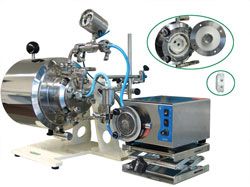The Challenges of Manufacturing Nanoparticles through Media Milling
Equipment and Processing Report
Creating nanoparticles can be challenging and requires appropriate equipment and techniques. Media milling or grinding is the best-established manufacturing method for nanoparticle production.
Nanoparticles are gaining the pharmaceutical industry’s attention as research and practical experience demonstrate their many uses. Among other applications, nanoparticles have proven suitable for anticancer medications and microarray platforms for genomics and proteomics. The oral, parenteral, transdermal, transmucosal, ocular, and pulmonary drug-delivery routes can effectively use nanoparticles, and implants can incorporate these particles, too. In a 2007 study, research firm Freedonia Group concluded that demand for nanotech-based medical supplies and devices in the US will exceed a value of $110 billion by 2016.
Creating nanoparticles by media milling
Creating nanoparticles can be challenging and requires appropriate equipment and techniques. Broadly speaking, nanoparticles are substances that are smaller than 100 nm. In the pharmaceutical industry, the term applies to substances as large as 500 nm. Media milling or grinding is the best-established manufacturing method for nanoparticle production. Its many benefits include:
- Excellent particle-size control
- Cost-effectiveness
- Equipment scalability from benchtop to production
- Limited or no contamination of the active ingredient
- Process repeatability
- Fulfillment of current good manufacturing practice production requirements.
Fine-bead mills are popular because of their simplicity and scalability. These machines are less expensive than alternative technologies (e.g., precipitation process techniques) and are often used in conjunction with plasma-gas process techniques. With the proper stabilizing agents, bead mills efficiently disperse output to discrete, submicrometer particle-size, stable dispersion (see Figure 1).

In bead mills, impact and shearing forces between moving beads grind suspended solid particles. The agitator shaft within the machine’s stator housing transmits kinetic energy to the grinding media.
Stress intensity and the number of contact points are the main factors that determine particle fineness. Stress intensity is influenced by the kinetic energy in the grinding beads. To produce a fine particle-size distribution, a process must have a high number of contact points. The smaller the grinding media, the more contact points touch the product. The rule of thumb is that particle size is equal to 1/1000 the size of the grinding media.
Achieving repeatable nanoparticle dispersions
Creating repeatable distributions of submicrometer-sized particles is essential for effective formulations. But nanoparticles’ tremendous surface areas and energy make it difficult to disperse them in liquids. Economically creating stable nanoparticle suspensions or dispersions requires a comminution process, which grinds particles into a fine particle-size distribution range, using 70–125-µm beads. This process, known as mild dispersion, relies on multiple mild contacts instead of one strong contact that could break or destroy the particles.
As bead size decreases, the stand-off distance (i.e., the space between the beads) decreases. Reduced stand-off distance works as a filtering mechanism that holds back large agglomerates and breaks them apart. The stand-off distance is roughly 44 µm for 1-mm beads and about 2 µm for 0.05-mm beads. Using 70–125-µm beads yields a stand-off distance of about 4 µm. Mild dispersion uses small beads that provide a small stand-off distance, thus holding back large particles and shearing them apart to their primary (i.e., nonagglomerated) size. This technique ensures particle-size uniformity, reduces particle damage, and maintains productive work speeds.
Mill choices
Selecting appropriate equipment is key to developing a repeatable process and creating an efficient workflow from the laboratory to full-scale production. New mills use beads as small as 100 µm in diameter and offer enhanced functionality such as an improved media-separation system and an ergonomic machine design for easy disassembly for cleaning. New mills also facilitate adequate product throughput at slow, low-energy motor speeds, thus preventing particle damage.
The ideal mill has “plug flow,” which refers to a hydraulic condition where all the molecules or particles move through the bead mill at a uniform velocity. Plug flow thus maintains a uniform grind and residence time. On the other hand, turbulence (i.e., intermixing between the grinding zones) in bead mills usually means that particles mix at a broad velocity range and requires manufacturers to perform rapid multiple-pass operations to achieve a narrow particle-size distribution (see Figure 2).

Selecting suitable construction materials for the grinding media and chamber prevents batch contamination. Grinding-zone parts made entirely of yttria zirconia, a high-strength ceramic, offer metal- and contamination-free grinding. Grinding beads made of plastic, glass, ceramics such as aluminum oxide and zirconium oxide, steel, and tungsten carbide are also available.
With the right media milling equipment, researchers can cost-effectively create nanoparticles for drug delivery that are uniform and readily available. The advantages of working with nanoparticles will help reduce the time and cost of product development while improving drug performance and patient outcomes.
Harry Way is a technical director, and Chris Esterly is a pharmaceutical sales specialist at NETZSCH Fine Particle Technology.
Drug Solutions Podcast: A Closer Look at mRNA in Oncology and Vaccines
April 30th 2024In this episode fo the Drug Solutions Podcast, etherna’s vice-president of Technology and Innovation, Stefaan De Koker, discusses the merits and challenges of using mRNA as the foundation for therapeutics in oncology as well as for vaccines.
PacBio Chosen as Tech Partner for Global Alzheimer’s Disease Research Project
April 23rd 2025The project, the North African Dementia Registry, will unite multiple entities for the purpose of developing a comprehensive dataset to advance the research community’s understanding of Alzheimer’s disease and other dementias in diverse populations.